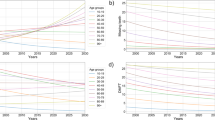Abstract
AIM: To investigate if active caries disease in the primary dentition can be used as a long-term predictor for active caries disease in the permanent dentition. STUDY DESIGN: Population-based longitudinal register study. METHODS: This study included all those born in 1987 living in Örebro county who came to the clinic for an examination at all three measuring points in 1990, 1993 and 2006 (n = 1,985, panel). The panel consisted of 77.3% of the baseline group (1990) and represented 60.0% of the three-year-olds in the population in 1990. Caries data were compared at the individual level and were broken down into the components of decayed, filled primary teeth (dft) and decayed surfaces (ds) (at three years and six years) and decayed filled permanent teeth (DFT) and decayed surfaces (DS) (at 19 years). DFT (dft) was used as an indicator of caries experience and DS (ds) as an indicator of active caries disease RESULTS: There was a poor correlation between active caries disease at six years of age and active caries disease at 19 years of age. A stronger correlation could be measured between dental caries experience at six years of age (primary dentition) and caries experience at 19 years of age. STATISTICS: Bivariate analyses were conducted by cross-tabulation and Chi-squared statistics. Multivariate analyses were conducted using binary multiple logistic regression with categorical data. CONCLUSIONS: The correlations between active caries disease in the primary dentition and active caries disease at 19 years of age were very low on an individual level. Using early caries disease as a predictive test for later caries disease showed low sensitivity and low specificity over a long time period.
Similar content being viewed by others
References
Crossner C, Unell L. A longitudinal study of dental health from the age of 14 to 41. Swed Dent J 2007; 31:65–74.
Davies JA, Smith PA, Pitts NB. Monitoring the Dental Health of Scottish Children Using Routinely Collected Data. Health Bulletin 1996; 54:348–354.
Ekbäck G, Persson C. Caries in five different socio-economic clusters in Örebro county: w 2012; 29:229–32
Harris R, Nicoll A, Adair P, Pine C. Risk factors for dental caries in young children: a systematic review. Comm Dent Health 2004; 21:71–85.
Hugoson A, Koch G, Göthberg C et al. Oral health of individuals aged 3–80 years in Jönköping, Sweden during 30 years (1973–2003). Part II. Review of clinical and radiological findings. Swed Dent J 2005; 29:139–155.
Mejàre I, Stenlund H, Zelezny-Holmlund C. Caries incidence and lesion progression from adolescence to young adulthood: a prospective 15-year cohort study in Sweden. Caries Res 2004; 38:130–141.
Ordell S, Aronsson K. Identifying deprived areas with populations at higher risk for oral disease Comm Dent Health 2002; 19:195.
Petersen PE. (2003a) The World Oral Health Report 2003: Continuous improvement of oral health in the 21st century — the approach of the WHO Global Oral Health Programme. Community Dent Oral Epidemiol; 31(Suppl 1), 3–24.
Petersen PE. (2003b) Continuous improvement of oral health in the 21st century- the approach of the WHO Global Oral Health Programme. The World Oral Health Report 2003.
Powell L. Caries prediction: a review of the literature. Community Dent Oral Epidemiol 1998; 26:361–371.
Regeringskansliet Prop 2007/08:49 Statligt tandvårdsstöd. [National support for dental care]. Stockholm 2007.
Reisine S, Psoter W. Socioeconomic status and selected behavioural determinants as risk factors for dental caries. J Dent Educ 2001; 65:1009–1016.
SBU Karies-diagnostik, riskbedömning och icke invasiv behandling SBU, [Dental caries, diagnostics, risks and non-invasive treatment]. Stockholm 2007.
Socialstyrelsen (2010) Karies hos barn och ungdomar. En lägesrapport för år 2008. [Dental caries among children and adolescents. A statement for the year 2008]. Stockholm.
Socialstyrelsen. (2011a) Nationella riktlinjer för vuxentandvård 2011 (National Guidelines for Adult Dental Care — summary. National Board of Health and Welfare). Edita Västra Aros, Västerås.
Socialstyrelsen (2011b) Tandvårdslagen.[Dental Act]. SFS 1985:125. Stockholm Torell P. Karies hos skolbarnen i Göteborg 1914-1978. [Dental caries among schoolchildren in Gothenburg 1914–1978]. Tandläkartidningen 1980; 72:230–232.
Vanobbergen J, Martens L, Lesaffre E, Bogaerts K, Declerck D. Assessing risk indicators for dental caries in the primary dentition. Community Dent Oral Epidemol 2001; 29:424–434.
Watt R, Sheiham A. Inequalities in oral health: a review of the evidence and recommendations for action. BDJ 1999; 187:6–12.
Author information
Authors and Affiliations
Corresponding author
Rights and permissions
About this article
Cite this article
Ekbäck, G., Ordell, S. & Unell, L. Can caries in the primary dentition be used to predict caries in the permanent dentition? An analysis of longitudinal individual data from 3–19 years of age in Sweden. European Archives of Paediatric Dentistry 13, 308–311 (2012). https://doi.org/10.1007/BF03320832
Published:
Issue Date:
DOI: https://doi.org/10.1007/BF03320832




